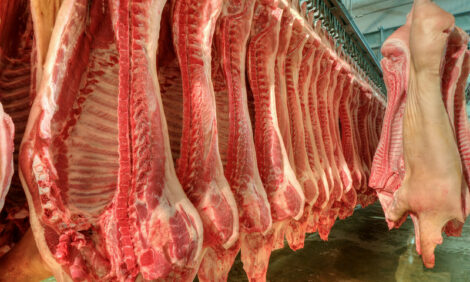



CME: Hog Slaughter Now at All-time Record Highs
US - Every afternoon USDA provides an estimate of the number of cattle and hogs processed by major slaughter facilities. Those estimates are collected from plant personnel based on how many shifts they are running and their normal processing capacity, reports Steiner Consulting Group, DLR Division, Inc.It is never a perfect number and sometimes there are significant corrections when USDA receives detailed data from FSIS inspectors. Those revised slaughter numbers are published on Thursday with a two week lag.
Still, market participants pay close attention to the daily estimates in order to gauge supply availability. Recently, we have seen a significant increase in the number of cattle/hogs processed and yet the impact on spot meat prices has been relatively muted.
In the case of beef, the average wholesale price (cutout) actually has increased since August even as fed slaughter was at a multi-year high. Pork prices have been pressured lower, which is normal for this time of year as supplies expand.
But even in the case of the pork cutout, prices have not declined as much as some would expect. Better meat protein demand, both domestic and export, has contributed to current price trends but data needed to calculate demand will not be available until November.
One factor that often is overlooked is the supply of beef or pork that gets traded in the open market. Only a percentage of the beef that is processed on a daily basis is traded/negotiated. Over the years end users have sought to benefit from the increased transparency of the Mandatory Price Reporting system and have shifted more of their purchases on a formula basis.
But there is still some product that participants still negotiate and this process makes up the crux of the market discovery process. Sometimes retailers will book a lot of product on a forward basis to support features for specific marketing windows.
Sometimes exporters will place big orders with packers in order to service major customers. And sometimes foodservice operators will decide to run promotions and look to cover those needs. When some or all of these things happen, then the cattle processed in a given day or week will go towards those standing orders, reducing the amount of product available in the spot market.
Offer prices tend to be firm when there are 5 rather than 15 or 20 loads to sell. The reverse is also the case. When the packer is left with a lot of product to sell on a given week suddenly negotiated volume will pick up, often resulting in lower prices.
What complicates matters is the amount of beef or pork that the packer will put in cold storage. Also, in recent years the consolidation along the supply chain means that some packers will divert product to their subsidiaries rather than sell it in the open market.
Still, the key point is that market participants need to pay attention not just at how many cattle or hogs are slaughtered each day but also at how much of that product actually shows up in the marketplace.

The charts above look to make this point. What we are showing are not the actual loads of beef or pork traded in a given week but the ratio of the loads traded in the negotiated market vs. fed cattle slaughter or hog slaughter during that week.
Hog slaughter is now at all-time record highs and yet last week USDA noted that there were 1,562 loads of pork traded in the negotiated market, 9.3 per cent less than the same week a year ago. The ratio of pork loads to slaughter was lower than in each of the last three years, even lower than in 2014.
The situation in beef has been even more dramatic. Looking at the ratio of choice beef loads to fed slaughter, the ratio is significantly lower than it was a year ago comparable to the levels we saw during the spring.








